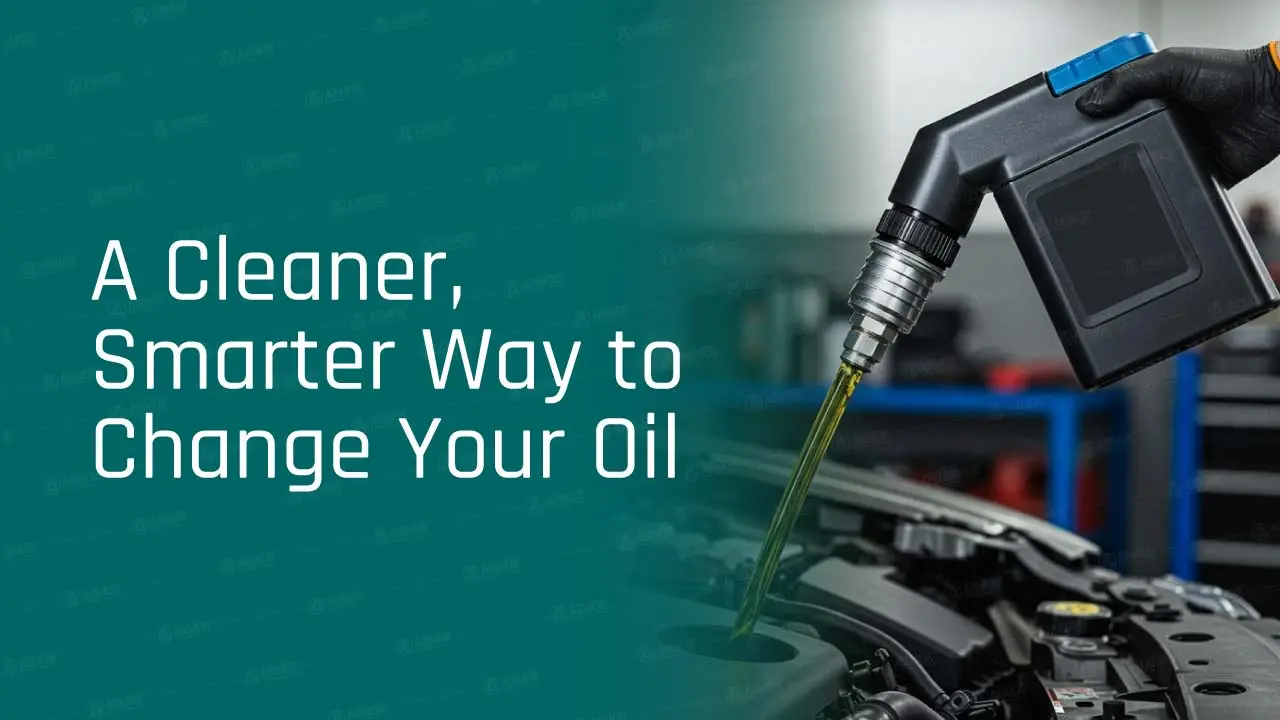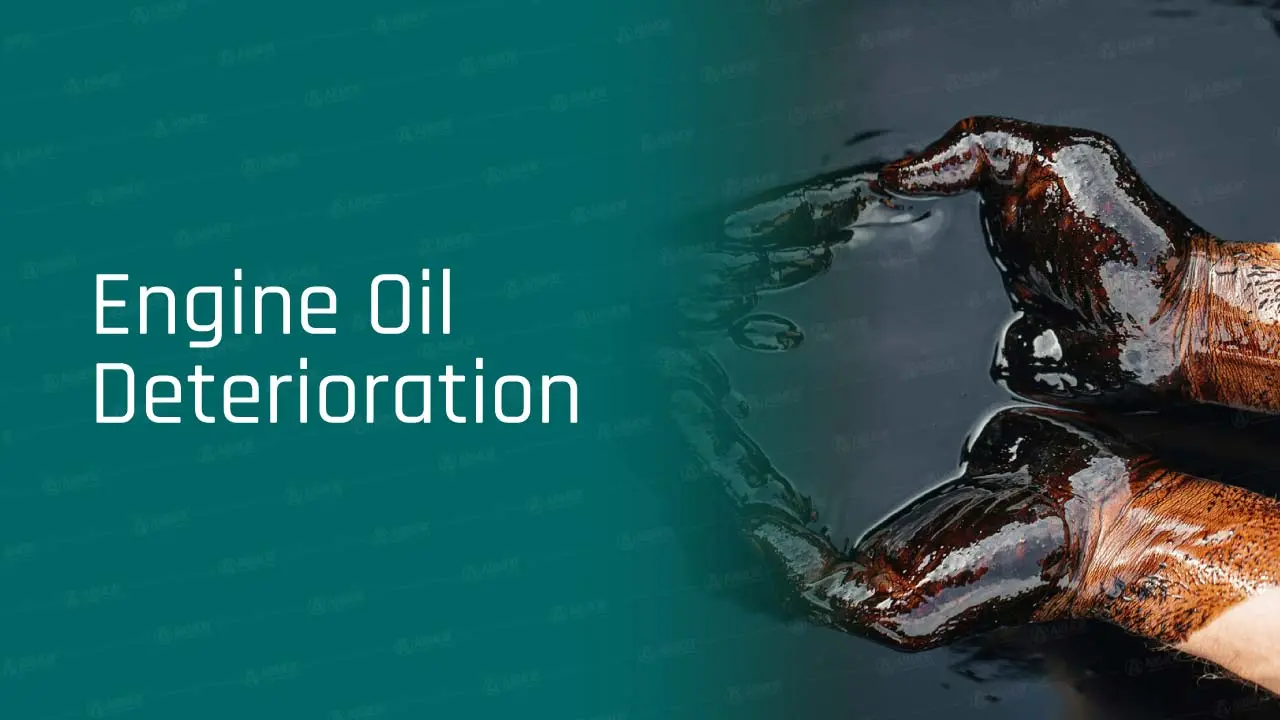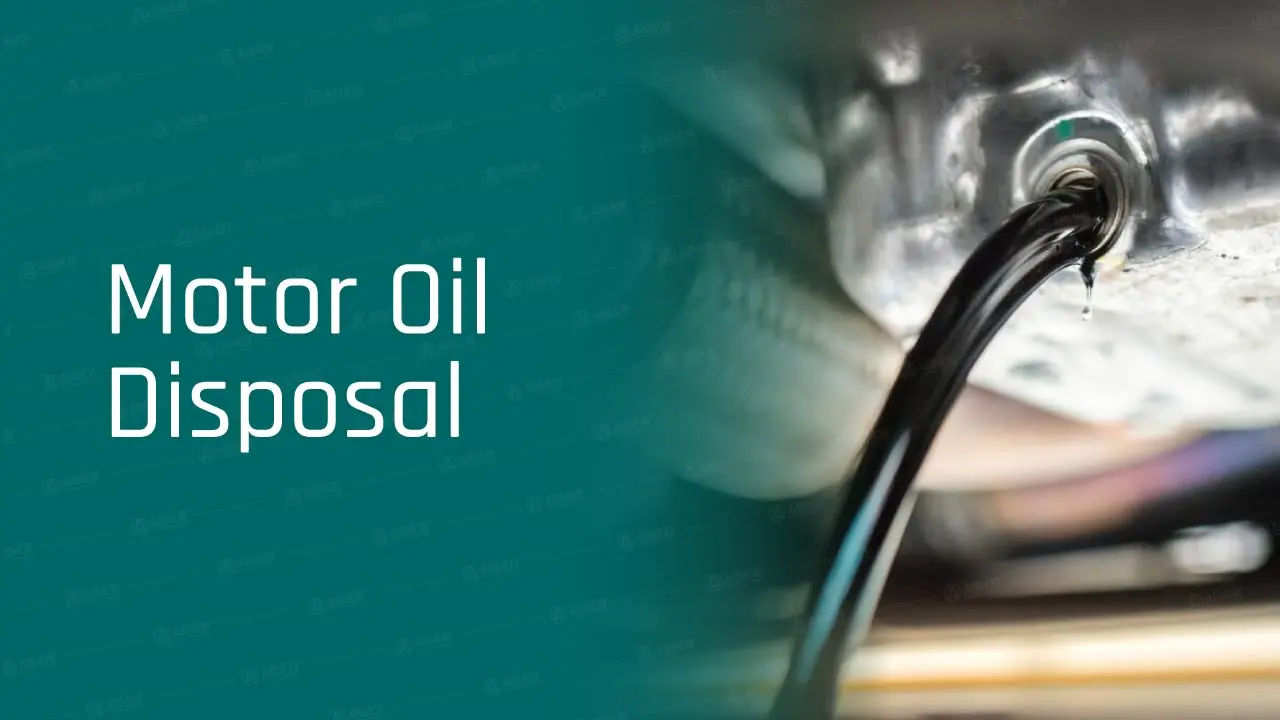- Armor Blog
- Consumer Education
- Motor Oil Extractor Pumps: A Cleaner, Smarter Way to Change Your Oil

The traditional oil change is often a messy and inconvenient task, involving crawling under the car and risking spills or stripped drain plugs. Fortunately, a motor oil extractor pump offers a cleaner, safer, and more efficient alternative, transforming a frustrating chore into a simple procedure.
This guide from Armor Lubricants will walk you through this innovative technology, explaining how it works, comparing the types available, and detailing the process so you can see why this tool is a favorite for DIYers and professionals alike.
What is a Motor Oil Extractor and How Does It Work?
A motor oil extractor pump is a tool designed to remove used oil through the engine’s dipstick tube, simplifying the oil change by using vacuum power instead of gravity.
The Core Concept: Vacuum Power Over Gravity
An oil extractor uses a pump to create negative pressure—a vacuum—inside a sealed container. This pressure difference forces oil from the engine’s sump up through a tube and into the collection reservoir. This method is so effective that many manufacturers, especially European brands like Mercedes-Benz and Audi, design their engines specifically for it. The dipstick tube acts as a service port, extending to the lowest point of the oil pan to ensure a complete removal. This intentional design simplifies maintenance, prevents damage to drain plugs, and pairs perfectly with top-mounted oil filters, making the extractor a manufacturer-endorsed tool.
Anatomy of an Oil Extractor
Most extractors have three main components:
- The Pump Mechanism: The heart of the unit, this can be a manual hand pump, a 12V electric motor, or a pneumatic valve that connects to an air compressor.
- The Reservoir/Container: This tank collects the oil. Manual and pneumatic models usually have an integrated reservoir, while compact electric models often pump oil into a separate container.
- Hoses and Probes: A set of tubes, including narrow probes designed to be inserted down the dipstick tube to the bottom of the oil pan.
A Comparative Analysis: Manual, Electric, and Pneumatic Extractors
Choosing the right motor oil extractor depends on your specific needs and budget. The three main types each offer unique advantages.
The DIY Favorite: Manual Extractors
A manual oil extractor uses a hand-operated pump to create a vacuum. After a few initial pumps, suction is established, allowing oil to be drawn out without continuous effort.
- Advantages: Their main benefits are portability and affordability. Since they require no external power, they can be used anywhere. Their simple design is ideal for beginners.
- Disadvantages: The primary drawbacks are slower extraction speed and the need for physical effort compared to powered models.
The Convenient Performer: 12V Electric Extractors
These units feature a small electric pump powered by the vehicle’s 12V battery.
- Advantages: Their main appeal is effortless, push-button operation, making the process fast and convenient. They are often compact and easy to store.
- Disadvantages: Most lack a built-in reservoir, requiring a separate waste container. They depend on a power source and their small motors can overheat with prolonged use.
The Professional’s Choice: Pneumatic Extractors
Pneumatic extractors connect to an air compressor for a powerful and consistent vacuum, offering the fastest oil extraction.
- Advantages: Unmatched speed and efficiency, making them perfect for large volumes or thick fluids. Many are versatile “combo” units that also include a manual pump.
- Disadvantages: They require an air compressor, which is a bulky and often expensive piece of equipment not all DIYers own.
| Feature | Manual Extractor | 12V Electric Extractor | Pneumatic Extractor |
| Power Source | Hand pump | Vehicle’s 12V battery | Air compressor |
| Extraction Speed | Slowest | Moderate to Fast | Fastest |
| Portability | High | High (pump only) | Low (requires compressor) |
| Typical Cost | Low to Moderate | Low to Moderate | Moderate to High |
| Key Advantage | Use anywhere, no power needed | Effortless, push-button operation | Unmatched speed and power |
| Key Disadvantage | Requires physical effort | Requires external reservoir, can overheat | Requires an air compressor |
| Ideal For | Occasional DIY use, budget-conscious users | Convenient single-car oil changes | Professional shops, high-volume use |
The Great Debate: Oil Extractor vs. Traditional Drain Plug
The most common question is whether extractors are as effective as the traditional gravity drain method. A close look at the evidence reveals a clear picture.
The Case for Extraction: Cleanliness, Safety, and Convenience
The arguments for using an oil extractor are compelling:
- Cleanliness: The closed system moves oil directly into a sealed container, virtually eliminating messy spills.
- Safety: Extraction removes the need to work under a jacked-up car and avoids contact with hot oil.
- Convenience and Speed: For cars with top-mounted filters, the entire job can be done from the engine bay in 15-20 minutes, saving the hassle of lifting the car.
- Preventing Damage: It eliminates the risk of stripping the oil drain plug or pan threads—a common and costly mistake.
Addressing the Criticisms: The Myth of “Leftover Sludge”
The main criticism is that extractors leave behind sludge and contaminants. This is largely a myth for three reasons:
- The Science of Suspension: Warming the engine before an oil change—a best practice for any method—suspends contaminants in the oil, allowing them to be removed.
- Thorough by Design: The extractor’s probe is designed to reach the very bottom of the oil pan, often removing more oil than a gravity drain. Tests show that only a negligible amount of oil remains after extraction.
- The Role of Quality Lubricants: In modern engines using quality lubricants with detergents, like those from Armor Lubricants, harmful sludge is inhibited anyway, making this concern less relevant.
When Draining Still Makes Sense
Draining still makes sense in a few scenarios:
- Bottom-Mounted Oil Filter: If your oil filter is on the bottom, you’ll be under the car anyway, reducing the extractor’s convenience.
- Inspecting a Used Car: On a newly purchased used car, inspecting the magnetic drain plug can reveal early signs of engine wear.
- Vehicle Design Limitations: Some older vehicle designs may not be compatible with an extractor probe, preventing a complete oil removal.
A Step-by-Step Guide to Using Your Oil Extractor
Following a systematic process ensures a clean and efficient oil change.
Step 1: Preparation is Key
Gather your tools: the extractor, new oil and filter, a filter wrench, funnel, and rags. Warm the engine for 5-10 minutes, then let it cool slightly so the oil is thin but not dangerously hot. Assemble the extractor and ensure all connections are airtight. For manual models, create an initial vacuum by pumping the handle as directed.
Step 2: The Extraction Process
Remove the oil filler cap and dipstick to allow airflow. Insert the extractor’s probe down the dipstick tube until it hits the bottom of the oil pan. Activate your pump—whether manual, electric, or pneumatic—to begin suction. The process takes 5-20 minutes and is complete when you hear a gurgling sound, indicating the pan is empty.
Step 3: Finishing the Job
Stop the pump and carefully withdraw the probe, wiping it clean to prevent drips. Now is the time to replace the oil filter. Finally, transfer the used oil from the extractor into a sealed container for recycling at an auto parts store or municipal center.
Step 4: Refilling with a Superior Oil
A clean extraction deserves a premium refill. Using a high-quality oil like Armor Lubricants’ full synthetic motor oil provides superior protection against wear and deposits. Consult your owner’s manual for the correct oil capacity. Add about 90% of the volume, then check the dipstick and top off as needed to reach the “FULL” mark.
How to Choose the Perfect Oil Extractor
Making the right choice comes down to matching the tool’s features to your needs.
Key Decision Factors
- Capacity: Ensure the reservoir can hold your engine’s entire oil capacity. 6-7 liters is sufficient for most cars, while trucks and SUVs may need 9 liters or more.
- Power Source: Choose between manual (portable, affordable), electric (convenient), or pneumatic (fastest) based on your needs and equipment.
- Hose Compatibility and Quality: A good kit will include several probe diameters to fit your vehicle. Hoses should be durable and heat-resistant.
- Build Quality and Materials: Look for a sturdy, heat-resistant tank, strong handles, and leak-proof seals to ensure durability and clean operation.
- Portability and Storage: Consider the unit’s size and weight. Features like carrying handles and onboard hose storage make the tool easier to manage.
Value-Added Features to Look For
- Overflow Shutoff Valve: A crucial safety feature that automatically stops suction when the tank is full, preventing messy overflows.
- Pour Spout: An ergonomic spout makes transferring used oil a clean, spill-free process.
- Pressure Release Valve: Allows you to safely depressurize the tank after use, making disassembly cleaner.
- Sealed Hose Storage: Integrated clips or compartments keep the oily tube contained, preventing drips during storage.
| Brand/Model Example | Type | Capacity | Noteworthy Features | Typical Price |
| OEMTools Manual Fluid Extractor | Manual | 1.4 gal / 5.3 L | Overflow shutoff valve, 5-foot hose | ~$80 |
| EWK Pneumatic/Manual Pump | Pneumatic / Manual | 1.7 gal / 6.5 L | Dual-power operation, eagle-mouth pour spout | ~$70 |
| Performance Tool Electric Pump | Electric | None (External) | Compact handheld design, fast flow rate | ~$30 |
| HT Moto Oil Extractor | Manual | 1.6 gal / 6.0 L | All-plastic for easy cleaning, removable pump | ~$105 |
Ensuring Longevity and Safety: Essential Care for Your Extractor
Proper care and safe operation will ensure your extractor provides years of reliable service.
Safety First: Your Pre-Operation Briefing
- Read the Manual: Always understand the manufacturer’s instructions and safety warnings before use.
- Wear PPE: Wear chemical-resistant gloves and safety glasses. Used motor oil is a hazardous material.
- Know Your Fluids: Never use the pump for gasoline or other highly flammable liquids to avoid damage and fire risk.
- Respect Limits: Operate the tool within its specified temperature and pressure ranges to prevent damage.
Post-Use Protocol: Cleaning and Storage for a Long Lifespan
- Drain Immediately: Empty the used oil into a disposal container right after your oil change.
- Clean the Unit: To clean the internal components, flush the system with a solvent like rubbing alcohol, which dissolves oil and evaporates quickly. Avoid using water.
- Store Properly: Keep your extractor in a clean, dry location away from direct sunlight to prevent the degradation of plastic and rubber parts.
- Inspect Regularly: Periodically check hoses and seals for wear and replace them as needed to maintain performance and prevent vacuum leaks.
Conclusion: Embracing a Smarter, Cleaner Oil Change for Peak Engine Health
The motor oil extractor pump makes vehicle maintenance cleaner, safer, and faster. It eliminates the need to work under the car and prevents damage to drain plugs, empowering car owners to perform oil changes with confidence. A modern maintenance method like extraction should be paired with a high-performance lubricant.
Refilling with a superior product like Armor Lubricants’ full synthetic engine oil ensures your engine receives the highest level of protection, promoting longevity and optimal performance. Choosing an extractor is a choice for smarter maintenance; choosing Armor Lubricants is a choice for uncompromising quality.



 logo of armor lubricants sub brand spear
logo of armor lubricants sub brand spear Armada lubricant
Armada lubricant Ace lubricants
Ace lubricants Perfect lubricants
Perfect lubricants Enzo lubricants
Enzo lubricants Lawrence lubricants
Lawrence lubricants